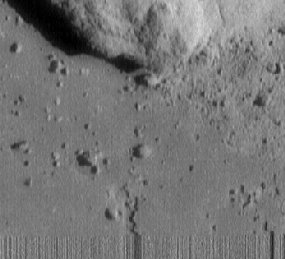This was the very last image taken by the NEAR spacecraft on February 12, 2001. It was taken from about 120 meters away from Eros. For reference, the rock at the top is about 4 meters across. The streaky lines at the bottom indicate loss of signal as the spacecraft touched down on the asteroid during transmission of this image.
Click on image for full size
Courtesy of NASA/JHUAPL (John Hopkins University, Applied Physics Laboratory
Click on image for full size
Courtesy of NASA/JHUAPL (John Hopkins University, Applied Physics Laboratory
Related links:
NEAR - It Isn't Over Yet!
News story originally written on February 15, 2001
On February, 12, 2001, the NEAR spacecraft became the first spacecraft to land on an asteroid! A team on Earth sent commands to NEAR that led it to a 4 mph touchdown on the surface of the asteroid Eros. They were giving commands from over 190 million miles away - talk about REMOTE control!
If NEAR had crashed into Eros instead of landing so gently, the NEAR mission would be over. But, NEAR can still communicate with Earth, so the mission is being extended for up to 10 days. During this time, scientists hope to collect information about the surface of Eros.
Last modified February 15, 2001 by Jennifer Bergman.















